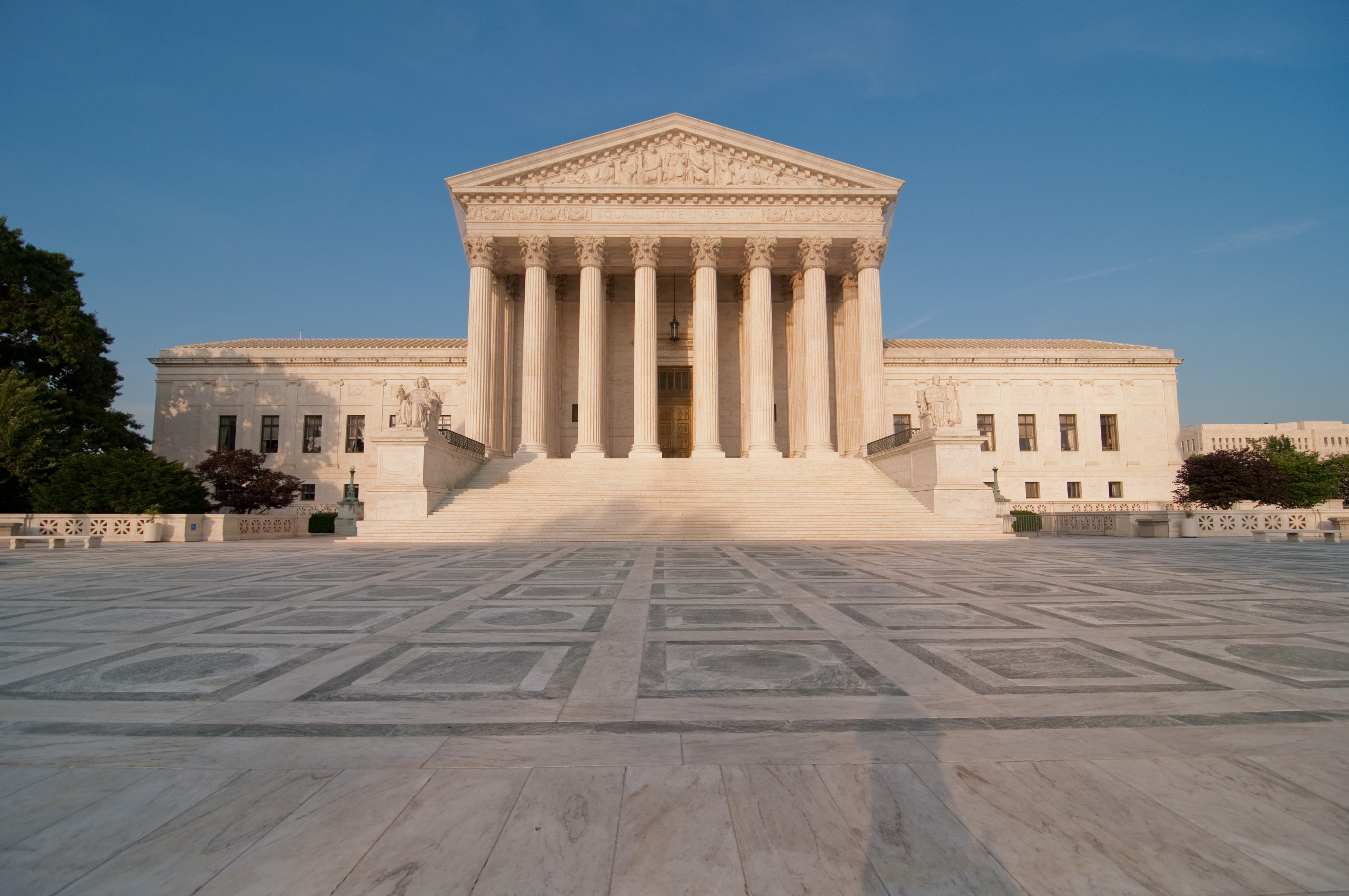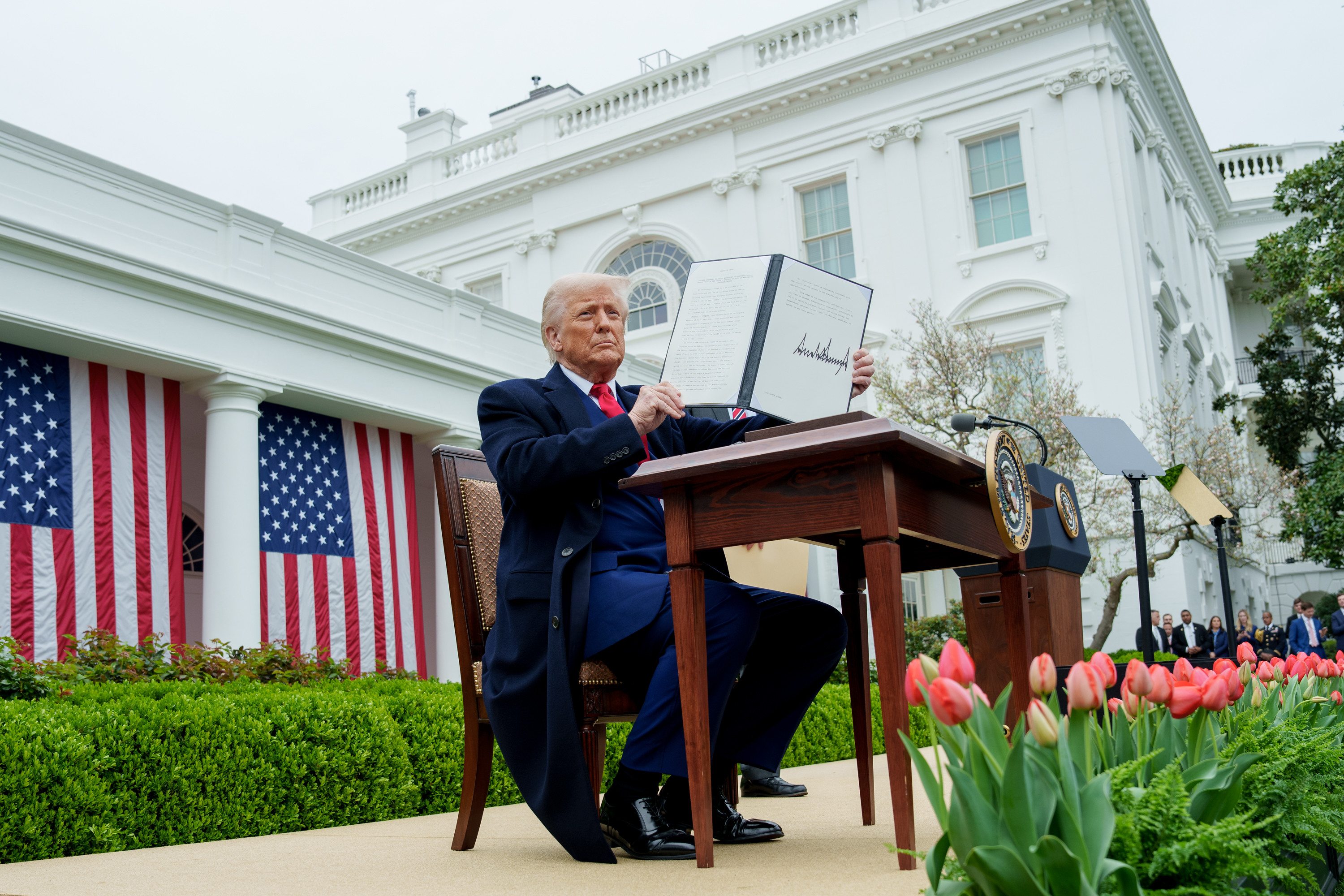A President and His Justices
A review of Cliff Sloan, “The Court at War: FDR, His Justices, and the World They Made” (PublicAffairs, 2023)

Published by The Lawfare Institute
in Cooperation With

From the main title of Cliff Sloan’s account of the Supreme Court’s response to World War II, a reader could be excused for expecting a focus on those cases that, at least as the justices portrayed them, concerned the exigencies of national security: the justly notorious Japanese exclusion cases, Hirabayashi and Korematsu, and the almost unbelievable execution-first-explanation-later Ex parte Quirin.
Those decisions are here, of course, but it seems to me the clue to Sloane’s real interest lies in his subtitle—in fact, in a single word. The word is “his”: FDR, his justices, and the world they made. On one level, that’s simply a description of the obvious: By July 1941, as Sloan observes, despite the failure of his court-packing scheme four years earlier, Franklin D. Roosevelt had nonetheless “effectively packed the court.” Simply by filling vacancies, he had appointed seven justices and elevated an eighth, Harlan Fiske Stone, to the chief justiceship. (The sole member of the Court who owed nothing to Roosevelt was Owen Roberts, a Hoover appointee, who would prove a fairly reliable ally.)
That Sloan’s project goes well beyond the descriptive is what makes the book not only interesting—how could it not be, populated as it is by larger-than-life characters confronting crises of historic dimension—but surprisingly relevant. He demonstrates that this was, in a profound and not just nominal sense, truly Roosevelt’s Supreme Court. Startling to modern eyes, the loyalty shown the president by “his” justices often bordered on sycophancy. For example, Stanley Reed, who had served as solicitor general before joining the Court, continued to send the president congratulatory and flattering notes. He asked for a personal meeting so he could be sure of “my understanding of your objectives” and offered at one point: “If I can be of any service, of course, I am always at your command.” (Reed was not without self-awareness. Following Roosevelt’s death on April 12, 1945, Reed confided to his colleague Felix Frankfurter that while he had been motivated to help FDR accomplish his objectives, now “I, myself, as a result of his death, feel very much more free and expect to be much more free in the future.”)
Frankfurter himself sent the president “a steady stream of often-oleaginous telegrams and letters” and even advised Secretary of War Henry Stimson on how to staff the military commission being set up to try eight German saboteurs whose fate the Court would imminently decide in the Quirin case. Robert H. Jackson, FDR’s trusted former attorney general, traveled with the president and offered to resign from the Court if he could be more useful in another capacity. William O. Douglas met regularly with Roosevelt and came close to replacing Vice President Henry Wallace on the 1944 ticket before being edged out by Sen. Harry Truman. The justices were “a fractious crew,” Sloan observes, “plagued by internal rivalries, bitter resentments, and behind-the-curtain feuds. But they were united in their loyalty to the President and frequently jostled for his favor.”
To Roosevelt, his justices were “members of his official family, trusted friends and allies.” He felt free to call on them for important missions. In the immediate aftermath of the attack on Pearl Harbor that brought the United States into the war, he summoned Justice James Byrnes, who prior to his Supreme Court appointment had been a powerful senator from South Carolina, to help draft the two War Powers Acts that gave sweeping new authority to the president and executive branch agencies. (In October 1942, after only 15 months on the Court, Byrnes resigned to become Roosevelt’s director of economic stabilization, in charge of managing the country’s economy. “For all practical purposes, you will be assistant President,” FDR told him.)
Roosevelt appointed Owen Roberts to head a presidential commission charged with determining how the country had been blindsided by the Japanese attack. Roberts immediately departed for Hawaii, producing a report in six weeks that, while it was eventually much criticized as superficial, served the immediate purpose of reassuring the public that whatever dereliction there was had not gone very deep. “The aura of impartiality conferred by a Supreme Court Justice overseeing four Commissioners with military backgrounds provided an important stamp of reliability—exactly as FDR had hoped,” Sloan writes.
Few if any of the incidents that Sloan recounts are new discoveries; his 100 pages of notes include voluminous citations to secondary sources and to justices’ papers that have been accessible for decades. What makes the book a valuable contribution to Supreme Court history is the deft way he marshals long-available evidence to stitch together a portrait of a Court that in important respects lost its bearings under the sway of the powerful man to whom its members owed their jobs.
The government’s fallacious argument for restricting and then confining nearly 100,000 Japanese American citizens has, of course, long since come to light, although it took until 2018 for the Court to finally get around to overruling Korematsu v. United States—anomalously, in the course of upholding Donald Trump’s Muslim travel ban. Ex parte Quirin, much less well known to the general public, is in some ways even more shocking. By the time the Supreme Court heard argument in July 1942 on whether the president had the authority to establish a military commission to try the eight would-be saboteurs—six Germans and two American citizens who had landed surreptitiously by submarine on beaches in Florida and on Long Island—the secret proceeding was already underway. And by the time the Court issued its opinion providing a rationale for the brief per curiam order that had permitted the commission to proceed, nearly three months had passed since the six Germans had been executed. (Roosevelt commuted the Americans’ death sentences to prison terms.)
Before the justices heard the case, Owen Roberts reported to his colleagues that Attorney General Francis Biddle had told him that Roosevelt was determined to have the saboteurs executed no matter what the Court decided. “It is difficult to say which was more egregiously improper,” Sloan observes, “the President’s determination to flout the Supreme Court if it did not give him what he wanted or the Attorney General’s conveying to the Justices the President’s explicit threat about the pending case.” The Quirin decision, “rife with errors and sloppy reasoning[,]” stands, according to Sloan, “as an object lesson of the harm that results from a Court that is too close to the President.”
The wartime cases offer a “cautionary tale,” Sloan writes, “a story of excessive deference to the Executive Branch and its inflated claims of national security at times of severe national stress.” The behavior of courts under wartime stress was also the subject of an underappreciated book by the late Chief Justice William H. Rehnquist, who wrote in “All the Laws but One: Civil Liberties in Wartime” that “it is neither desirable nor is it remotely likely that civil liberty will occupy as favored a position in wartime as it does in peacetime.” Consequently, Rehnquist continued, “it is both desirable and likely that more careful attention will be paid by the courts to the basis for the government’s claims of necessity as a basis for curtailing civil liberty.”
Rehnquist published his book in 1998, a mere three years before the terrorist attacks of 9/11 brought war back to the Supreme Court’s doorstep. Surprisingly, in the first round of cases to reach the Court challenging the detention at Guantanamo of those deemed “enemy combatants,” the Rehnquist Court pushed back on the George W. Bush administration’s claims of unbridled executive authority. Rehnquist himself joined Justice Sandra Day O’Connor’s opinion in Hamdi v. Rumsfeld (2004), which contained the most famous line to emerge from the early Guantanamo litigation: “A state of war is not a blank check for the President when it comes to the rights of the Nation’s citizens.” Rehnquist and O’Connor were soon both gone and, following the Boumediene decision in 2008, the Court retreated, leaving the fate of the Guantanamo detainees in the unfriendly hands of the U.S. Court of Appeals for the D.C. Circuit. (In a forthcoming and sure to be noticed memoir, titled “Vision,” Judge David Tatel, now retired from that court, has some choice words for its refusal to follow the Supreme Court’s instructions to afford the Guantanamo detainees a “meaningful opportunity” to challenge their confinement.)
Cliff Sloan is, I am confident, intimately familiar with the Guantanamo saga. A law clerk to Justice John Paul Stevens during the October 1985 term, he now teaches at Georgetown University following a long legal career in both private and public sectors, including service in the State Department as the Obama administration’s special envoy for closure of the Guantanamo prison. There were 132 detainees when he left that position after 18 months at the end of 2014, reportedly in frustration with the Pentagon’s slow-rolling of the transfers he had negotiated with other countries; a decade later, 30 remain.
How does today’s court, shaped by Donald Trump, Mitch McConnell, and the Federalist Society, measure up? Would it stand up to a president in either war or peace? That’s the question running silently through these pages, the question that makes a book of history so unexpectedly relevant. As the country grapples with life and politics after the erasure of the 50-year-old constitutional right to abortion, it’s hard not to conjure the image of candidate Trump, during the Oct. 19, 2016, presidential debate, boasting that his election would mean that Roe v. Wade would be overturned “automatically.” Since there is no actual law in the Dobbs opinion that Trump’s three appointees made possible, it’s not unfair to describe Roe’s demise as, in fact, the automatic result of Trump’s success.
Toward the end of his book, Sloan breaks the fourth wall, coming very close to addressing the current justices directly. He writes:
Particularly in our current era, when party affiliations correlate to Justices’ positions and divisions more than at any time in our history, the War Court’s failings send an important message. Justices must not be afraid to challenge the President who appointed them, even at the risk of alienating or infuriating that President or the President’s supporters.
Sloan’s definition of “war court” is expansive, encompassing not only the explicitly war-related cases but the Court’s entire docket from early 1942 until FDR’s death. His point is not simply to be comprehensive, but to show how the justices’ perceptions of the country’s interests during this period influenced the outcome of cases that on the surface had nothing to do with the ongoing military conflict. While this is not a new observation, Sloan accomplishes here what he achieved with his account of the justices’ undue loyalty to Roosevelt: to stitch together separate incidents and cases into a composite portrait that shows how the war permeated every aspect of the Court’s behavior. “There are no two fronts for America in this war,” no separation between foreign and domestic, FDR declared in his 1944 State of the Union address. There were no two fronts for the Supreme Court either.
An early example was Skinner v. Oklahoma, decided in June 1942. The Court unanimously struck down a state law permitting the forced sterilization of those convicted of three felonies involving “moral turpitude.” In his opinion for the Court, Justice Douglas described procreation as “one of the basic civil rights of man,” noting that “in evil or reckless hands,” the state’s power to sterilize “can cause races or types which are inimical to the dominant group to wither and disappear.” Sloan points out that Douglas’s intent to draw a contrast with the Nazis’ program of forced sterilization, well known by 1942, was unmistakable. Skinner became a foundational precedent for the Court’s later decisions dealing with personal privacy and reproductive freedom.
In 1944, the Court invalidated the so-called white primary, a device that had allowed the Democratic Party in Texas to exclude African Americans from voting in the party’s primary election. Since a Democratic nomination was tantamount to election, exclusion from voting in the primary effectively deprived Black citizens of the right to vote. The decision, Smith v. Allwright, in a case argued by Thurgood Marshall, overturned a nine-year-old precedent that had treated the Democratic Party as a private association free to limit membership as it chose. A crucially important step on the road to the civil rights revolution, the decision was widely understood in the context of the war. “It strikes down a form of discrimination that is a reproach to any freedom-loving people and is particularly anachronistic in a country fighting a world-wide war against tyranny and oppression,” read a Washington Post editorial. The Black community popularized the phrase “Double V” to express the twin goals of victory over fascism overseas and victory over racism at home.
The Court’s best-known wartime reversal came in the 1943 flag-salute case, West Virginia State Board of Education v. Barnette. A month after Pearl Harbor, the state board had passed a resolution to require all students in public schools to salute the flag. The board appeared on firm constitutional ground: In 1940, in Minersville School District v. Gobitis, the Supreme Court had upheld the expulsion of two Jehovah’s Witness children who had refused to salute the flag as required by their Pennsylvania school district. Frankfurter had written the 8-1 Gobitis opinion, larding it with encomiums to patriotism, the symbolic importance of the flag, and the “binding tie of cohesive sentiment.”
The Gobitis decision was on the one hand extremely unpopular among the nation’s elites, prompting more than 170 negative newspaper editorials, including one in the New York Herald Tribune that called it “a step in the ‘Heil Hitler’ direction.” On the other hand, vigilante mobs took the decision as license to treat Jehovah’s Witnesses as traitors. Witnesses were viciously attacked by, among others, members of the American Legion. In short order, three members of Frankfurter’s majority, Douglas, Hugo Black, and Frank Murphy, disavowed their Gobitis votes. By the time the Barnette case reached the Court, two other members of the majority, Chief Justice Charles Evans Hughes and Justice James McReynolds, had retired, replaced by Jackson and Wiley Rutledge, both of whom had criticized Gobitis. Joined by Chief Justice Stone, who as an associate justice had been the lone dissenter in Gobitis, there were now six votes to overturn the 1940 decision.
Jackson received the assignment, and his majority opinion made the wartime context clear. Noting that “the extension of the right arm in this salute to the flag is not the Nazi-Fascist salute, although quite similar to it,” he wrote that “[t]hose who begin coercive elimination of dissent soon find themselves exterminating dissenters.” Pointedly rebuffing Frankfurter’s invocation of the flag as a symbol of “national unity,” Jackson, a master of language, wrote: “Compulsory unification of opinion achieves only the unanimity of the graveyard.”
Sloan notes that not only the Court’s membership but the war itself had changed between the dark days of 1940—the British evacuated Dunkirk on the day Gobitis was announced—and the brighter prospects that had emerged by the time the Court issued Barnette on Flag Day, June 14, 1943. (Law clerks had taken to calling Gobitis “Felix’s Fall-of-France opinion.”) Context mattered, and the context was clear. A New York Times editorial column called Barnette “a clear contradiction of the Hitler method—that every child, indeed every grown-up, must learn to click his heels, salute and shout ‘Heil Hitler.’ ” The war, Sloan observes, had prompted “some of the best and worst decisions since the founding of the republic.” Barnette, wrung from the Gobitis mistake, was one of the best.
Early in “The Court at War,” Sloan sets the scene at noon on Dec. 8, 1941, as Roosevelt prepared to address a special joint session of Congress on the catastrophic event of the previous day. The Supreme Court would ordinarily have been in session, but all nine justices instead were seated in the middle of the front row in the House chamber. The president, looking out at the audience, would have had no trouble seeing “his” justices and might well have taken comfort from the sight.
Contrast that with the scene last month as President Biden gave his State of the Union address. Six justices were in attendance: Chief Justice John Roberts and Justices Neil Gorsuch, Brett Kavanaugh, Sonia Sotomayor, Elena Kagan, and Ketanji Brown Jackson. Four presidents were responsible for this array: George W. Bush, Donald Trump, Barack Obama, and Biden himself. No current, former or, let’s assume, future president will be able to look at a row of members of the Supreme Court and see only “his” (or “her”) justices. That, at least, “The Court at War” instructs us, is something to be grateful for.





